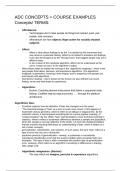ADC CONCEPTS + COURSE EXAMPLES
Concepts/ TERMS:
- Affordances:
- Technologies don’t make people do things but instead, push, pull,
enable, and constrain.
- Affordances are how objects shape action for socially situated
subjects.
- Affect:
- Affect is what allows feelings to be felt. It is defined as the movement that
may result in a particular feeling. Affect is not limited to emotions and feelings.
It can also be thought of as the "driving forces" that suggest people may act in
different ways.
- In the context of the Facebook algorithm, affect can be understood as the
user's "reason to react" to the algorithm's output.
- Affect theory helps to explain the concept of the "algorithmic imaginary," which is the
way people think about, perceive, and experience algorithms. The algorithmic
imaginary is generative, meaning it both shapes and is shaped by how people use
and interact with algorithms.
- See Bucher reading + Alex’s lecture (in the lecture we also defined it as mood,
feeling, sense and what leads to experience).
- Algorithms:
- Bucher: Carefully planned instructions that follow a sequential order
- Bishop: Codified step-by-step processes ….. through the platform
architecture
Algorithmic bias:
- Crawford explores how the definition of bias has changed over the years:
- “The historical lineage of “bias” as a term is much more recent. It first appears in
fourteenth-century geometry, where it refers to an oblique or diagonal line. By the
sixteenth century, it had acquired something like its current popular meaning, of
“undue prejudice.” By the 1900s, “bias” had developed a more technical meaning in
statistics, where it refers to systematic differences between a sample and population,
when the sample is not truly reflective of the whole. It is from this statistical tradition
that the machine learning field draws its understanding of bias, where it relates to a
set of other concepts:
- generalization, classification, and variance. In such cases, the term “bias” refers to a
type of error that can occur during this
- predictive process of generalization—namely, a systematic or consistently
reproduced classification error that the system exhibits when presented with new
examples. This type of bias is often contrasted with another type of generalization
error, variance, which refers to an algorithm’s sensitivity to differences in training
data. (page 134)
- Algorithmic imaginaries: (Bucher):
- The way which we imagine, perceive & experience algorithms
, - they have the power to shape social life to various degrees
- A key concept introduced by Bucher and Alex in week 10. It describes how people
understand and experience algorithms. It is defined as "ways of thinking about
what algorithms are, what they should be, and how they function" (Bucher). It is not
merely a collection of false beliefs, but rather a complex and nuanced set of ideas,
perceptions, and feelings that shape how people interact with algorithmic systems.
- The algorithmic imaginary is not a fixed or static entity but rather a dynamic and
evolving one, shaped by individual experiences, cultural narratives, and the ongoing
development of algorithms themselves.
- Importantly, the algorithmic imaginary plays a generative role in molding algorithms.
This means that the way people think about and react to algorithms can influence
how these systems are designed and implemented
- Algorithmic lore: (bishop)
- A collection of assumptions/strategies based on observing pattern in an
algorithmic society (Think of the algorithmic ‘experts’)
- EXAMPLE: ‘If I post a video at 5PM youtube’s algorithm will boost it”
It reminds of “folklore” discussed in Week 3 - Memes. It’s the narratives surrounding
algorithms. However, note the difference between this and algorithmic imaginary. The lore is
more specific and is practical advice, while the imaginary is more of an abstract concept,
overall experience and idea.
- Attention economy:
- The attention economy is a system that involves “paying, receiving,
andn seeking... the attention of other human beings”, which is
“intrinsically limited and not replaceable by anything else.”
Archival culture: Archival culture refers to the practices and values surrounding the
collection, organization, and preservation of data, media, and information.
- this can include the way platforms and individuals save and store online
content, such as social media posts or digital files, for future reference or
cultural memory.
- Archival culture raises questions about access, control, and who gets to
decide what is preserved or forgotten.
- (NAPALM girl photo from the vietnam war)
- Artificial intelligence (AI)
- learning, problem-solving, and decision-making. AI is foundational to
algorithms, personalization, and machine learning, but raises concerns
about bias, surveillance, and ecological impacts.
- tied to the concept of the megamachine, highlighting its global material
and human labor dependencies.
- Artivism:




